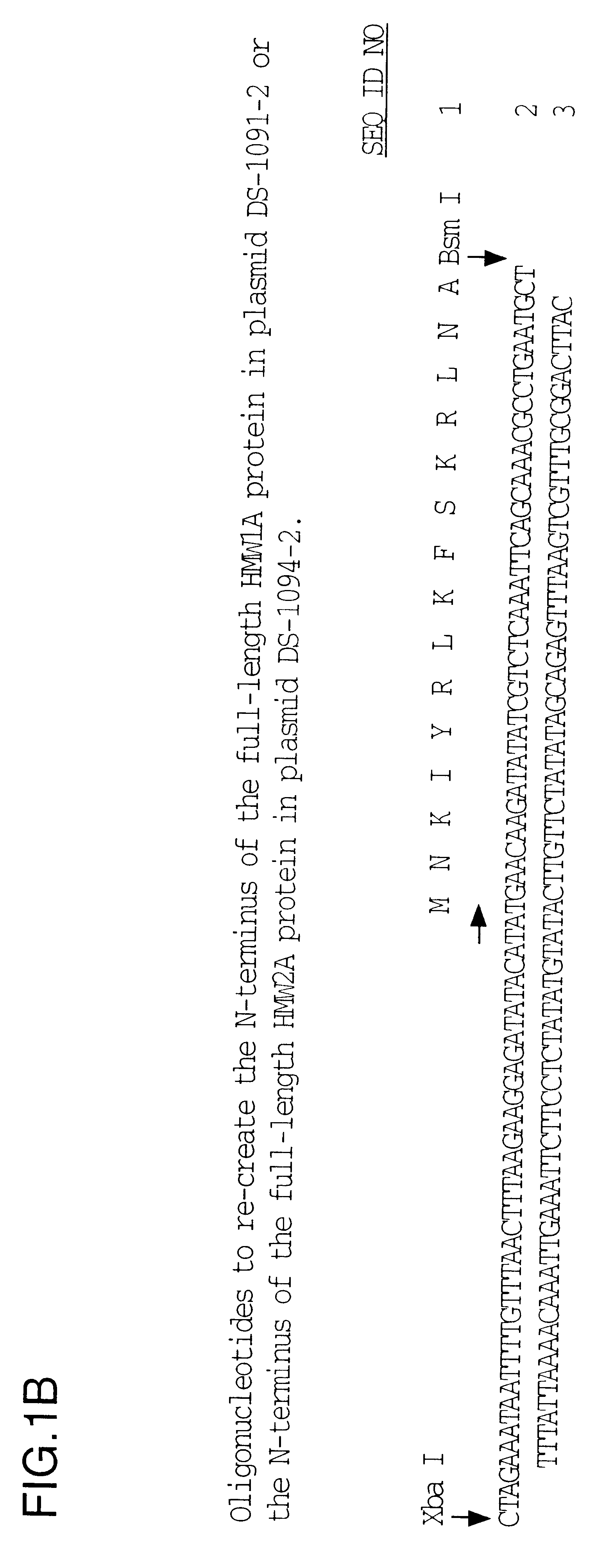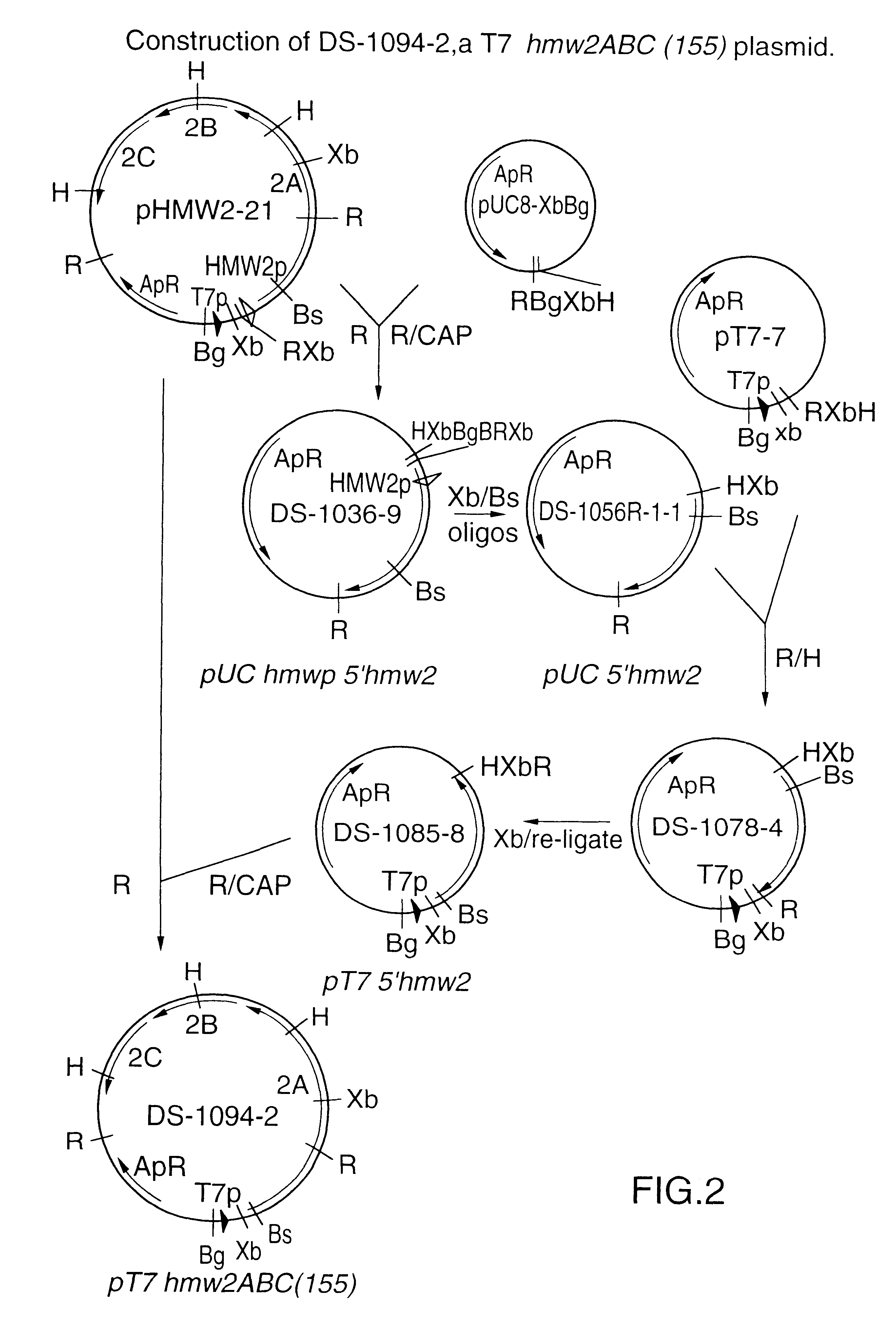Protective recombinant Haemophilus influenzae high molecular weight proteins
a technology of haemophilus influenzae and high molecular weight, which is applied in the field of protective recombinant haemophilus influenzae high molecular weight proteins, can solve the problems of unexpected requirement of otherwise redundant accessory genes, many of the causative organisms of otitis media are resistant to antibiotic treatment, and purified recombinant proteins are not protectiv
- Summary
- Abstract
- Description
- Claims
- Application Information
AI Technical Summary
Benefits of technology
Problems solved by technology
Method used
Image
Examples
example 1
This Example describes the construction of plasmid DS-1091-2 that expresses the hmw1ABC genes encoding the full-length 160 kDa HMW1A protein.
Plasmid pHMW1-15 (ref. 8) contains about 400 bp of 5'-flanking region, including the hmw1promoter, inserted between the T7 promoter and the start of the hmw1ABC coding region (FIG. 1). There is a unique Bgl II site in the multiple cloning site of pHMW1-15 and a unique BamH I site in the coding region of hmw1A. The 2.2 kb Bgl II-BamH I fragment was subcloned for further manipulation, generating plasmid DS-1035-12. A 400 bp Xba I-Bsm I fragment containing the 5'-flanking region was replaced by approximately 86 bp oligonucleotides (FIG. 1B) that joined the T7 promoter directly to the ATG start codon of the hmw1A gene in plasmid DS-1055R-2. The 1.5 kb Xba I-BamH I fragment from DS-1055R-2 was inserted into pHMW1-15 that had been digested with the same enzymes to generate plasmid DS-1091-2.
example 2
This Example describes the construction of plasmid DS-1094-2 that expresses the hmw2ABC genes encoding the full-length 155 kDa HMW2A protein.
Plasmid pHMW2-21 (ref. 10) contains about 800 bp of 5'-flanking sequence, including the hmw2 promoter, between the T7 promoter and the start of the hmw2ABC coding sequence (FIG. 2). Plasmid pHMW2-21 has two EcoR I sites, one in the multiple cloning site, and one within the coding sequence of the hmw2A gene. The 2.5 kb EcoR I fragment was subcloned for further manipulation, generating plasmid DS-1036-9. The approximately 800 bp Xba I-Bsm I fragment containing the 5'-flanking sequences, was replaced by the same approximately 86 bp oligonucleotides that were used for hmw1 (FIG. 1B), to join the T7 promoter directly to the ATG start codon of hmw2A, generating plasmid DS-1056R-1-1. An intermediate plasmid (DS-1078-4) was necessary to introduce convenient restriction enzyme sites, and the Xba I insert was excised, then re-ligated to change orientatio...
example 3
This Example illustrates the construction of plasmid DS-1046-1-1 that expresses the hmw1ABC genes encoding the mature 125 kDa HMW1A protein.
Plasmid pHMW1-15 (ref. 8) contains a Xba I site within the T7 promoter sequence and a unique BamH I site within the coding sequence of the mature HMW1A protein (FIG. 3A). The 1.8 kb Xba I-BamH I fragment of pHMW1-15 was deleted and replaced by an approximately 114 bp Xba I-BamH I fragment generated from oligonucleotides (FIG. 3B). The resultant 11.3 kb plasmid, DS-1046-1-1, thus contains the T7 promoter joined in frame with the hmw1ABC operon that encodes the mature 125 kDa HMW1A protein.
PUM
| Property | Measurement | Unit |
|---|---|---|
| temperature | aaaaa | aaaaa |
| temperatures | aaaaa | aaaaa |
| temperatures | aaaaa | aaaaa |
Abstract
Description
Claims
Application Information
 Login to View More
Login to View More - R&D
- Intellectual Property
- Life Sciences
- Materials
- Tech Scout
- Unparalleled Data Quality
- Higher Quality Content
- 60% Fewer Hallucinations
Browse by: Latest US Patents, China's latest patents, Technical Efficacy Thesaurus, Application Domain, Technology Topic, Popular Technical Reports.
© 2025 PatSnap. All rights reserved.Legal|Privacy policy|Modern Slavery Act Transparency Statement|Sitemap|About US| Contact US: help@patsnap.com



